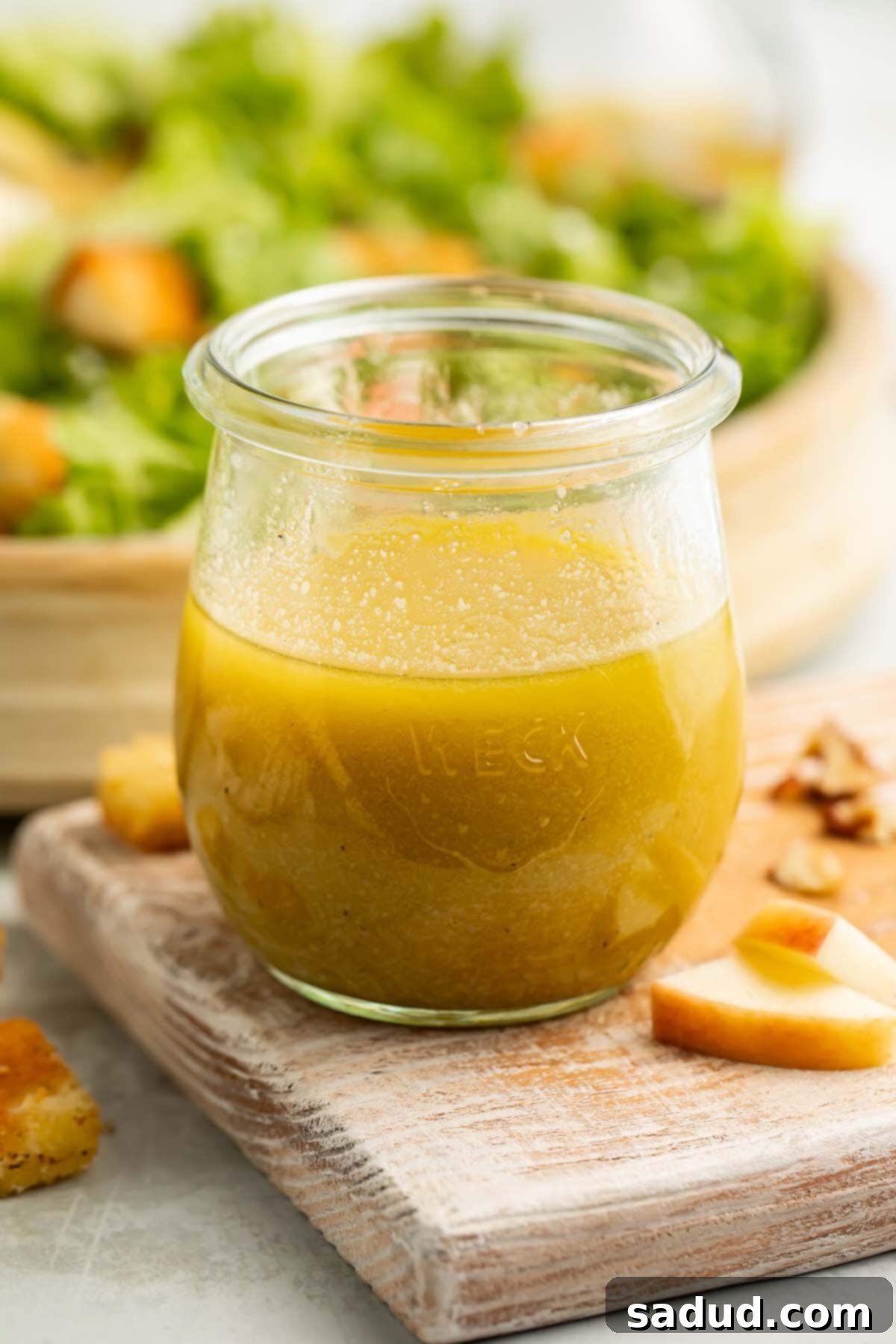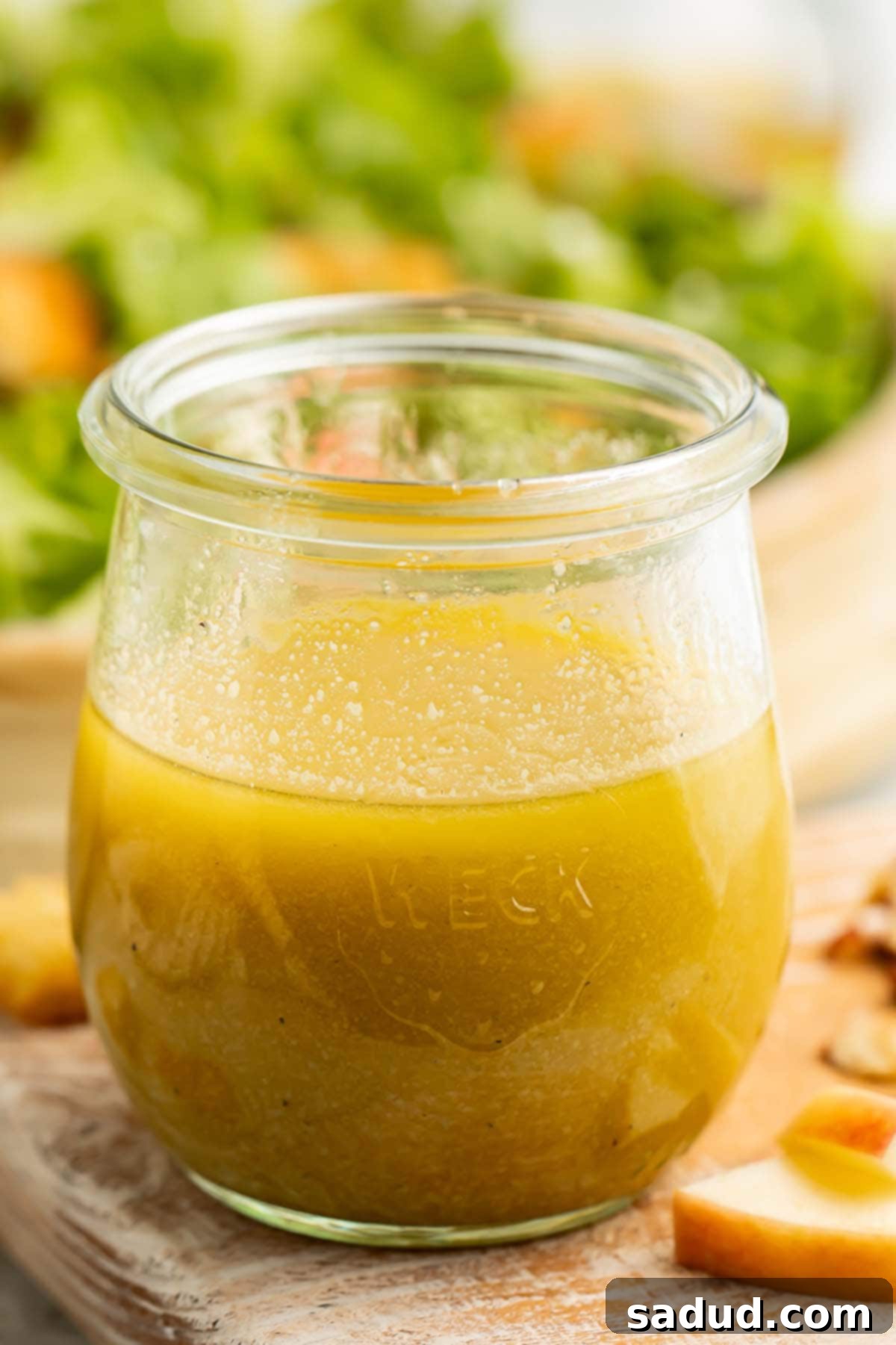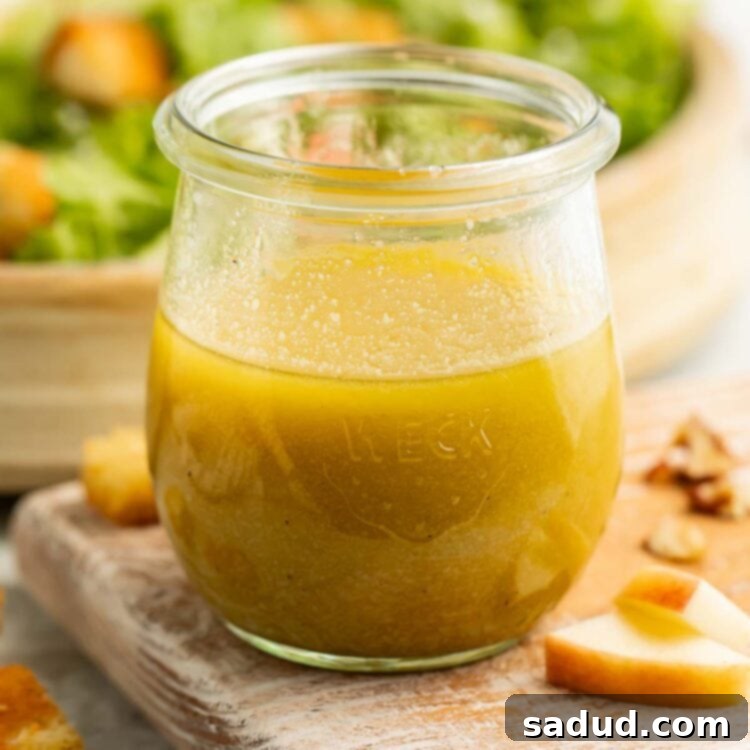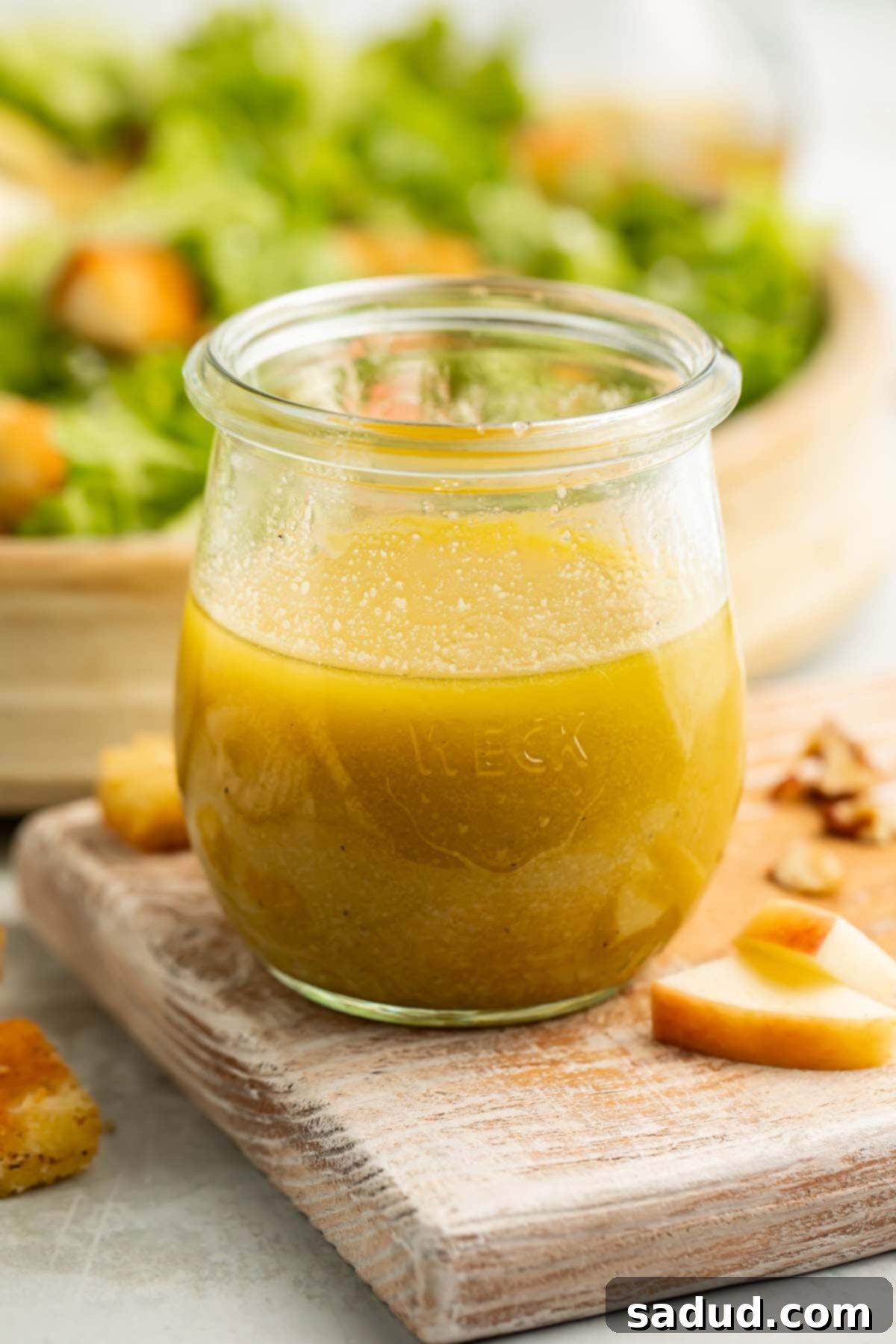Homemade Apple Cider Vinaigrette: Your Go-To Recipe for Easy, Healthy & Flavorful Salads
Discover the secret to a truly outstanding salad with this incredibly easy and delicious homemade apple cider vinaigrette recipe. Forget about those bland, preservative-laden store-bought dressings; in less than 10 minutes, with just five simple ingredients and absolutely no cooking required, you can create a vibrant, tangy, and refreshing dressing that will elevate almost any dish. This vinaigrette isn’t just a topping; it’s a game-changer, promising to impress not only your guests but also yourself with its superior taste and fresh appeal.
Making your own salad dressing offers a myriad of benefits that go far beyond just flavor. You gain complete control over the quality of ingredients, allowing you to choose organic, high-quality oils and vinegars, and avoid artificial additives, sugars, and unhealthy fats often found in commercial options. This particular apple cider vinaigrette shines with its perfect balance of sharp, sweet, and savory notes, making it a versatile staple you’ll want to keep in your refrigerator at all times. It’s the ideal way to add a burst of wholesome flavor to your greens, grain bowls, and even roasted vegetables, making healthy eating both convenient and delectable.

Why You’ll Love This Homemade Apple Cider Vinaigrette
There are countless reasons why this apple cider vinaigrette will become a permanent fixture in your culinary repertoire. From its exceptional flavor profile to its health benefits and sheer simplicity, this recipe truly stands out as a must-try for any home cook.
-
Incredibly Light, Refreshing, and Flavorful
This apple cider vinaigrette is renowned for its light and refreshing quality, adding a delightful zesty kick to almost any salad. Its crisp, tangy notes beautifully complement a variety of greens and toppings, enhancing the natural flavors without overwhelming them. Imagine it drizzled over a robust pecan and goat cheese salad, where the acidity cuts through the richness, or bringing life to a spinach salad with crisp apples and tart cranberries. It’s equally fantastic on a fresh strawberry goat cheese salad, providing a bright counterpoint to the sweet fruit and creamy cheese. Its versatility means it pairs wonderfully with everything from simple garden salads to more elaborate culinary creations, making vegetables more appealing and enjoyable for everyone at the table.
-
Effortless & Quick: Zero Cooking Required
One of the most appealing aspects of this vinaigrette is its incredible ease of preparation. There is absolutely no cooking involved, making it a perfect last-minute addition to any meal. You only need a literal handful of staple ingredients, and the entire process takes less than 10 minutes from start to finish. This makes it an ideal choice for busy weeknights, quick meal prep sessions, or when you simply want a fresh, homemade touch without spending hours in the kitchen. Just a few stirs and whisks, and you have a gourmet-quality dressing ready to serve, far surpassing the taste and freshness of most store-bought alternatives that often lack the vibrant zest of a freshly made dressing.
-
Packed with the Potential Benefits of Apple Cider Vinegar (ACV)
Beyond its fantastic taste, apple cider vinaigrette offers the potential health benefits associated with its star ingredient: apple cider vinegar (ACV). ACV, particularly the raw, unfiltered variety containing “the Mother,” has been a subject of widespread interest in wellness circles for years. While more extensive scientific research is needed to definitively prove all claims, many proponents suggest ACV can contribute to overall well-being. For instance, some preliminary studies indicate it may help lower blood sugar levels and assist in managing type 2 diabetes by improving insulin sensitivity. Additionally, ACV is thought to increase feelings of satiety, which could lead to consuming fewer calories and potentially support weight loss efforts. Some even explore its use in home remedies for issues like dry skin and eczema, aiming to rebalance the skin’s natural pH. It’s crucial to remember that these are potential benefits, and definitive scientific backing is still developing. Therefore, always approach these claims with caution and, most importantly, consult a medical professional before starting or stopping any medications or treatments, especially if you have underlying health conditions.
Chef’s Expert Tips for the Best Vinaigrette
Mastering this simple vinaigrette is easy with a few insider tips designed to ensure perfect results every time, from ingredient selection to optimal storage and revival techniques.
-
Storage and Longevity
Apple cider vinaigrette is an excellent dressing to prepare in advance and keep on hand for quick meals throughout the week. For a while, incorporating a single or double batch of this vinaigrette into my weekly meal prep on Sundays was a routine that saved me valuable time and ensured healthy eating. Simply refrigerate the dressing in an airtight container, and it will keep for up to 1 week. Keep in mind that homemade dressings, lacking the artificial stabilizers and preservatives found in store-bought varieties, naturally have a shorter shelf life. Don’t be alarmed if the olive oil solidifies when cold; this is a natural occurrence and does not affect the quality or taste of the dressing. Just let the vinaigrette come to room temperature for about 15-30 minutes, then give it a vigorous whisk until everything is smoothly re-emulsified. It will be as good as new and ready to elevate your next meal!
-
Choosing the Right Apple Cider Vinegar: Embrace “The Mother”
For the best flavor and potential health benefits, it’s highly recommended to seek out an organic, unfiltered, raw apple cider vinegar. This specific type is easily identifiable as it contains what’s known as “The Mother.” Don’t be put off by its cloudy appearance or the somewhat gelatinous layer at the bottom of the bottle; this is precisely what you want! “The Mother” is a complex network of beneficial bacteria, proteins, and enzymes that forms naturally during the fermentation process of ACV. It’s often considered the most nutrient-rich part of the vinegar, believed to house the majority of its purported health advantages, including probiotics that support gut health and enzymes vital for digestion. While research hasn’t definitively proven that “The Mother” offers specific health benefits beyond what the vinegar itself provides, many enthusiasts swear by its presence for a more potent and beneficial product. Opting for this raw, unfiltered version ensures you’re getting the most out of your apple cider vinaigrette, both in terms of flavor and potential wellness advantages.

Why Homemade Vinaigrette Triumphs Over Store-Bought
While store shelves are lined with countless dressing options, crafting your own apple cider vinaigrette at home offers undeniable advantages. The most significant benefit is unparalleled freshness. You’re using freshly combined ingredients, free from the stabilizers, emulsifiers, and artificial preservatives that give commercial dressings their extended shelf life. This translates directly to a brighter, more vibrant flavor that simply cannot be replicated by bottled alternatives that have sat on a shelf for months.
Furthermore, making your own gives you complete control over the ingredients. You can select high-quality extra virgin olive oil for its rich flavor and beneficial monounsaturated fats, and choose a raw, unfiltered apple cider vinegar with “the Mother” for its potential health properties. This allows you to avoid artificial flavors, excessive sugars, and unhealthy, processed oils (like soybean or canola oil) often found in mass-produced dressings. For those with dietary restrictions or allergies, homemade dressings are a fantastic way to ensure your food is safe and perfectly aligned with your health goals. It’s a simple choice for better taste, better health, and better peace of mind, transforming an ordinary salad into an extraordinary culinary experience.
Key Ingredients Spotlight
This simple apple cider vinaigrette relies on a few core ingredients, each playing a crucial role in creating its perfectly balanced flavor and stable texture. Understanding their individual contributions highlights why this recipe is so effective.
- Dijon Mustard: More than just for flavor, Dijon mustard acts as a powerful natural emulsifier. Its natural compounds help to bind the oil and vinegar together, preventing them from separating too quickly and creating a smooth, creamy texture for your vinaigrette. It also adds a subtle tang, a touch of spice, and a layer of savory depth that complements the apple cider vinegar beautifully, giving the dressing character.
- Raw Apple Cider Vinegar (with “The Mother”): As previously discussed, this is the undeniable star of the show. Its distinctive tart and slightly fruity flavor forms the acidic backbone of the dressing, providing that signature zing. Opting for raw, unfiltered ACV with “the Mother” ensures you’re getting the fullest, most authentic apple flavor and any potential probiotic benefits that contribute to gut health.
- High-Quality Olive Oil: The choice of olive oil significantly impacts the final taste and mouthfeel of your vinaigrette. A good quality extra virgin olive oil will lend a rich, sometimes peppery, grassy, or fruity note that enhances the overall complexity of the dressing. It also provides the essential fat content for a luxurious, silky mouthfeel and helps in carrying the flavors across your palate, making the dressing satisfying and well-rounded.
- Salt & Freshly Cracked Black Pepper: These aren’t just for basic seasoning; they are critical for balancing and enhancing all the other flavors. Salt brightens the taste, bringing out the nuances of the vinegar and mustard, while freshly cracked black pepper adds a warm, aromatic spice that ties everything together with a subtle kick. Adjusting these to your personal preference is key to a perfectly seasoned and harmoniously flavored dressing that truly sings.
More Delicious Homemade Condiments We Can’t Get Enough Of
- Strawberry Vinaigrette
- Homemade Buffalo Ranch Dressing
- Creamy Italian Dressing
- Vegan BBQ Sauce
- Au Jus Recipe (Made With or Without Drippings)
- Cilantro Lime Dressing
- Creamy Dill Sauce for Salmon
- Ginger Salad Dressing Recipe
- Avocado Salad Dressing
- Mango Habanero Sauce
- Hot Bacon Dressing
- Southwest Salad Dressing
If you loved this recipe as much as we did, don’t forget to leave us a review below. ★ Follow Easy Healthy Recipes on Pinterest, Facebook, and Instagram, too!
For more delicious recipes, visit our sister sites, 40 Aprons and Easy Cheap Recipes.

Apple Cider Vinaigrette
 Cheryl Malik
Cheryl Malik
Print
SaveSaved!
Ingredients
- 1 tablespoon dijon mustard
- 1 tablespoon raw apple cider vinegar containing “the Mother”
- 8 tablespoons high-quality olive oil
- salt to taste
- freshly cracked black pepper to taste
Equipment
-
Small mixing bowl or large measuring cup
-
Whisk
Instructions
-
Combine 1 tablespoon Dijon mustard and 1 tablespoon raw apple cider vinegar in a small mixing bowl or a large measuring cup. Vigorously whisk these ingredients together until they are well incorporated and slightly thickened. This initial mix helps start the emulsification process.
-
Gradually add 8 tablespoons of high-quality olive oil to the mixture, 1 to 2 tablespoons at a time. Continue to whisk constantly and thoroughly, ensuring each addition of olive oil is fully emulsified into the mustard-vinegar base before adding more. This slow, steady addition is crucial for a perfectly smooth and stable vinaigrette that won’t separate easily.
-
Once all the olive oil has been completely incorporated and the dressing is beautifully emulsified, season the vinaigrette generously with salt and freshly cracked black pepper to your preferred taste. Whisk again to ensure the seasonings are well distributed throughout the dressing. Taste and adjust the salt and/or pepper as needed, aiming for a perfectly balanced flavor that excites your palate.
-
When you are satisfied with the vinaigrette’s flavor and consistency, drizzle the desired amount over your fresh salad and enjoy immediately. For longer storage, transfer any remaining vinaigrette to an airtight container and refrigerate it until you’re ready to serve, ensuring its freshness for days to come.
Notes
- Storage: To maintain its freshness and flavor, refrigerate the salad dressing in an airtight container immediately after preparation. It will remain delicious for up to 1 week. If you notice the olive oil has solidified when cold, simply allow the dressing to come to room temperature for about 15-30 minutes, then whisk it vigorously until all ingredients are smoothly reincorporated. This will restore its original texture and consistency, making it ready to enjoy once again.
Variations & Customizations: Make It Your Own
While this classic apple cider vinaigrette is perfect as is, it’s also a fantastic base for customization. Feel free to experiment with these ideas to tailor the dressing to your personal taste or specific meal, making it truly unique every time you prepare it:
- Add Aromatics: Mince a small clove of fresh garlic or a shallot and whisk it into the mustard and vinegar mixture for an extra layer of savory depth and aromatic complexity.
- Herbaceous Notes: Incorporate finely chopped fresh herbs like parsley, chives, dill, or a touch of fresh thyme. Dried herbs can also work, but remember that their flavor is more concentrated, so use them sparingly.
- Sweeten It Up: If you prefer a slightly sweeter dressing, add a small amount (1/2 to 1 teaspoon) of maple syrup, honey, or a pinch of stevia. This can beautifully balance the tartness of the ACV, especially if you’re serving it with sweeter ingredients.
- Spice It Up: For a subtle kick, add a tiny pinch of red pepper flakes or a dash of cayenne pepper. Start with a small amount and add more to taste.
- Citrus Boost: A squeeze of fresh lemon juice or a hint of lemon zest can further enhance the brightness and add another dimension of citrusy zest, making the dressing even more lively.
- Different Vinegars: While apple cider vinegar is key here, you can certainly try other vinegars for a different flavor profile, such as white wine vinegar for a milder taste or balsamic vinegar for a richer, sweeter result (though it won’t be an “apple cider” vinaigrette then!).
Perfect Pairings & Serving Suggestions
This versatile apple cider vinaigrette isn’t just for green salads. Its bright, tangy, and slightly sweet flavor makes it a phenomenal accompaniment to a wide array of dishes, offering a healthy and delicious way to enhance your meals. Here are some ideas to inspire your culinary creativity:
- Classic Green Salads: Obviously, it’s the perfect complement for any mixed green salad. Enhance it further by adding toasted nuts, crunchy seeds, dried fruit, or crumbled cheese for extra texture and flavor dimension.
- Grain Bowls: Drizzle generously over warm or cold grain bowls featuring quinoa, farro, brown rice, or couscous, along with roasted vegetables and your favorite lean protein for a complete and satisfying meal.
- Roasted Vegetables: Toss warm roasted vegetables like Brussels sprouts, asparagus, broccoli, carrots, or sweet potatoes with this vinaigrette immediately after cooking. The heat helps the dressing meld with the vegetables, adding a fresh, zesty, and irresistible finish.
- Marinade: Use it as a quick and flavorful marinade for chicken, fish (especially salmon or cod), pork, or tofu. The acidity helps tenderize and infuse flavor, making your proteins more succulent and tasty.
- Pasta Salads: A refreshing and light alternative to creamy, heavy dressings for cold pasta salads, especially those with Mediterranean-inspired ingredients like cherry tomatoes, cucumbers, olives, and feta cheese.
- Potato or Lentil Salads: Brighten up hearty potato or lentil salads with this vibrant dressing. It provides a much-needed lift and cuts through the richness of the star ingredients.
- Coleslaw: For a lighter, tangier alternative to mayonnaise-based coleslaw dressings, this apple cider vinaigrette offers a refreshing twist that is both flavorful and healthier.
- Fruit Salads: Believe it or not, a light drizzle over a fruit salad with berries, apples, grapes, or melon can be surprisingly delicious, enhancing the fruits’ natural sweetness with a subtle tang.
Nutrition Information
Number of total servings shown is approximate. Actual number of servings will depend on your preferred portion sizes.
Nutritional values shown are general guidelines and reflect information for 1 serving using the ingredients listed, not including any optional ingredients. Actual macros may vary slightly depending on specific brands and types of ingredients used.
To determine the weight of one serving, prepare the recipe as instructed. Weigh the finished recipe, then divide the weight of the finished recipe (not including the weight of the container the food is in) by the desired number of servings. Result will be the weight of one serving.
